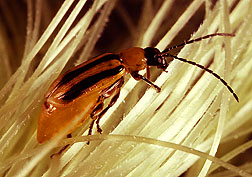This page has been archived and is being provided for reference purposes only. The page is no longer being updated, and therefore, links on the page may be invalid.
|
|
Study Probes Spread of U.S. Corn Pest in Europe
By Luis PonsNovember 10, 2005
The Agricultural Research Service (ARS) has helped shed new light on the spread in Europe of the western corn rootworm beetle, the most destructive pest of corn in the United States.
It was thought that the European spread of this pest, Diabrotica virgifera virgifera, could be traced exclusively to its accidental 1992 introduction from North America into the former Yugoslavia.
But a new study, headed by researchers Thomas Guillemaud and Nicholas Miller at Institut National de la Recherche Agronomique (INRA) in Sophia Antipolis, France, has found that it’s the result of at least three independent transatlantic introductions. This suggests that such incursions may be occurring more often than previously thought.
The study, described in the current issue of Science, entailed analysis of genetic variation in European and American western corn rootworm populations, specifically at eight microsatellite loci within their DNA.
Molecular biologist Kyung Seok Kim of ARS’ Corn Insects and Crop Genetics Research Unit in Ames, Iowa, developed the microsatellite DNA markers needed for the study. His work and ARS cooperation with INRA accelerated the research findings by about a year.
ARS is the U.S. Department of Agriculture’s chief scientific research agency.
Western corn rootworms cost U.S. growers about $1 billion annually in yield losses and control measures. Young larvae feed on root hairs and small roots, while larger larvae feed on primary roots.
Kim explained that the pests are usually most easily controlled by rotating crops between corn and soybean. Eggs laid in corn hatch during the soybean phase, depriving the pests of suitable food.
He added that the findings also bear significance because of the emergence of a new variant of the western corn rootworm in the United States that lays its eggs in soybeans and whose offspring hatch in corn. This variant has not yet been detected in Europe.

